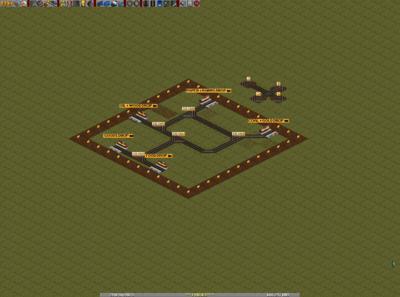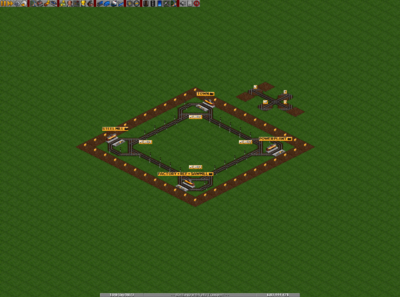Difference between revisions of "Relevant Directions"
From #openttdcoop wiki
(Created page with 'When you make a major hub in one of our games, be it a BBH, SLH or MSH the last thing you want to do is make more connections than necessary. Sometimes it can however…') |
m (Added to categories) |
||
| (2 intermediate revisions by 2 users not shown) | |||
| Line 5: | Line 5: | ||
Have a look at this dummy plan. This type of plan is quite common. Similar lay-outs have been used in public server games before and it is likely they will be used again. | Have a look at this dummy plan. This type of plan is quite common. Similar lay-outs have been used in public server games before and it is likely they will be used again. | ||
| − | [[File:SLHplan.PNG|400px|thumb|none|A network plan]] | + | [[File:SLHplan.PNG|400px|thumb|none|A network plan in a temperate climate map]] |
The first SLH we're going to build will be one the main loop, between BBH02 and BBH03. It is quite obvious this will have to be a full SLH with exits and entries from both sides. On plans with loops such as this one it is of course possible to connect it to only one direction, as trains will also get to wherever they're going if you make them cover 70% of the loop instead of 30. However, this will trigger the roundabout effect, you do not want this. It means you force trains to take a longer route, meaning your trains will be on their way longer and you'll need more trains to service your industry. Also this puts more stress on the mainline at parts where trains don't have to go. So just connect it to both directions. | The first SLH we're going to build will be one the main loop, between BBH02 and BBH03. It is quite obvious this will have to be a full SLH with exits and entries from both sides. On plans with loops such as this one it is of course possible to connect it to only one direction, as trains will also get to wherever they're going if you make them cover 70% of the loop instead of 30. However, this will trigger the roundabout effect, you do not want this. It means you force trains to take a longer route, meaning your trains will be on their way longer and you'll need more trains to service your industry. Also this puts more stress on the mainline at parts where trains don't have to go. So just connect it to both directions. | ||
| Line 15: | Line 15: | ||
== Relevant directions for [[BBH|Backbone hubs]]== | == Relevant directions for [[BBH|Backbone hubs]]== | ||
| − | + | For this part we'll use the dummy plan below: | |
| + | |||
| + | [[File:BBHplan.PNG|400px|thumb|none|A network plan in a sub-arctic climate map]] | ||
| + | |||
| + | First we're going to build BBH02. This should be pretty obvious; the BBH should be connected to all 3 directions. Unless the plan states that SLH construction is prohibited at certain places ("no SLH construction on main loop", for example), you should always expect that primary traffic is coming from every direction. | ||
| + | |||
| + | BBH04 is up next. As you can see, the only stations further west of BBH04 are the Food Drop and the Goods Drop. Both food and goods will enter BBH04 from the north. However, this does not mean you only have to connect it to the northbound mainline; there could be SLHs on the mainlines between BBH04 and the drops that want to go south. | ||
| + | |||
| + | BBH05 is the easy one here; it does not require a straight-through direction from the Goods Drop to the Food Drop. Both drops don't accept primaries and there is no way secondaries will ever come from the opposite drop. | ||
| + | |||
| + | == Relevant directions for [[MSH|Main station hubs]] == | ||
| + | |||
| + | For our third and final case we'll use a different type of plan, a loop-based one. | ||
| + | Keep in mind that the main loop is a two-way one. | ||
| + | |||
| + | [[File:MSHplan.PNG|400px|thumb|none|A two-way-loop-based plan in a temperate map]] | ||
| + | |||
| + | MSH02 should be obvious; they should be connected to both directions. | ||
| + | |||
| + | MSH04 is different; as you can see it connects to a Steel Mill station. This station will consist of both an iron drop and a steel pickup. The iron drop should be connected to both directions as primaries can come from anywhere on the map. The steel pickup, however, only has to be connected to the southbound ML; toward the factory, as steel will only go to the factory. | ||
| + | |||
| + | MSH01 is the most interesting case in this example. All goods will come from the Factory/Refinery/Sawmill. As you can see there are both a western and an eastern route between the goods pickup and the goods drop. This is quite a special case; it is rarely seen. It is very hard to determine what route the goods trains will take, it can depend on the tiniest [[penalties|penalty]]. Of course it's needless to connect the goods drop to both directions. This time it's your call; just connect it to either direction. | ||
| + | |||
| + | MSH03 requires some coordination; the goods pickup only has to be connected to the same direction as the goods drop. The primary drop should, of course, be connected to both directions. | ||
| + | |||
| + | [[Category:Guides]] | ||
| + | [[Category:Basic networking| ]] | ||
Latest revision as of 08:35, 4 December 2013
When you make a major hub in one of our games, be it a BBH, SLH or MSH the last thing you want to do is make more connections than necessary. Sometimes it can however be hard to determine which connections are relevant and which are not. In this article I'll try to explain which connections are relevant and which are not using some dummy plans.
Relevant directions for Sideline hubs
Have a look at this dummy plan. This type of plan is quite common. Similar lay-outs have been used in public server games before and it is likely they will be used again.
The first SLH we're going to build will be one the main loop, between BBH02 and BBH03. It is quite obvious this will have to be a full SLH with exits and entries from both sides. On plans with loops such as this one it is of course possible to connect it to only one direction, as trains will also get to wherever they're going if you make them cover 70% of the loop instead of 30. However, this will trigger the roundabout effect, you do not want this. It means you force trains to take a longer route, meaning your trains will be on their way longer and you'll need more trains to service your industry. Also this puts more stress on the mainline at parts where trains don't have to go. So just connect it to both directions.
Our second SLH will be on the piece of ML between BBH01 and the iron drop. In our case there are no iron ore mines that could potentially be connected to our new SLH. It is tempting to only connect the sideline hub to the Southwest bound mainline, as no train will go to the iron ore drop. You should however keep in mind that industries spawn by themselves and we also often prospect them ourselves. A new iron ore mine could appear near the SLH and be connected it its respective sideline. Whoever connects the iron mine may not notice the SLH is only connected southbound. Of course the iron trains will reach the drop in time, by making a full loop over the central ML loop. This will again, put un-needed stress on the ML, which is unwanted. So connect the SLH to both the Soutwest-bound and the Northeast-bound mainlines. Even though the connection is not relevant at the time built, it may become so in the future.
In the third case we will build a SLH between BBH04 and BBH05. This time you're lucky; you only have to connect it to the eastbound ML. The only main stations that are further down the mainline are a Steel Drop and a Goods Drop. These are both drops for secondary industries. There is no way trains carrying these cargoes will ever come off the sideline as only primary industries are connected to the sideline.
Relevant directions for Backbone hubs
For this part we'll use the dummy plan below:
First we're going to build BBH02. This should be pretty obvious; the BBH should be connected to all 3 directions. Unless the plan states that SLH construction is prohibited at certain places ("no SLH construction on main loop", for example), you should always expect that primary traffic is coming from every direction.
BBH04 is up next. As you can see, the only stations further west of BBH04 are the Food Drop and the Goods Drop. Both food and goods will enter BBH04 from the north. However, this does not mean you only have to connect it to the northbound mainline; there could be SLHs on the mainlines between BBH04 and the drops that want to go south.
BBH05 is the easy one here; it does not require a straight-through direction from the Goods Drop to the Food Drop. Both drops don't accept primaries and there is no way secondaries will ever come from the opposite drop.
Relevant directions for Main station hubs
For our third and final case we'll use a different type of plan, a loop-based one. Keep in mind that the main loop is a two-way one.
MSH02 should be obvious; they should be connected to both directions.
MSH04 is different; as you can see it connects to a Steel Mill station. This station will consist of both an iron drop and a steel pickup. The iron drop should be connected to both directions as primaries can come from anywhere on the map. The steel pickup, however, only has to be connected to the southbound ML; toward the factory, as steel will only go to the factory.
MSH01 is the most interesting case in this example. All goods will come from the Factory/Refinery/Sawmill. As you can see there are both a western and an eastern route between the goods pickup and the goods drop. This is quite a special case; it is rarely seen. It is very hard to determine what route the goods trains will take, it can depend on the tiniest penalty. Of course it's needless to connect the goods drop to both directions. This time it's your call; just connect it to either direction.
MSH03 requires some coordination; the goods pickup only has to be connected to the same direction as the goods drop. The primary drop should, of course, be connected to both directions.


